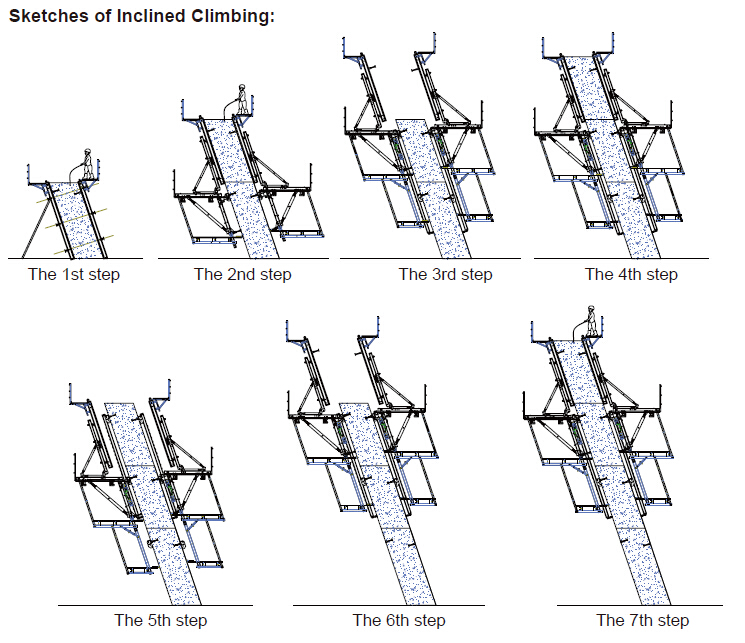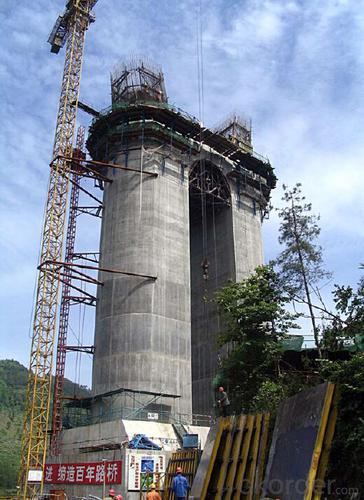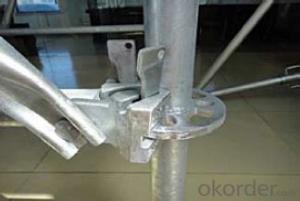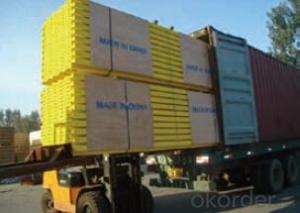Auto-Climbing Bracket ACB100 & ACB50 for formwork and scaffolding system
- Loading Port:
- Tianjin
- Payment Terms:
- TT OR LC
- Min Order Qty:
- 50 m²
- Supply Capability:
- 1000 m²/month
OKorder Service Pledge
OKorder Financial Service
You Might Also Like
Auto-climbing Bracket ACB100 & ACB50
The power of the auto-climbing formwork is the hydraulic system, which includes the oil cylinder
and two commutators. The commutators can control the climbing of climbing rail and the bracket.
The steel rail and the bracket can inter-climbing, so the whole system will climb up steadily.
Cranes are not needed during the construction. It’s easy to operate, highly efficient and safe. It’s
the best choice for the construction of high buildings and bridges.
There are mainly two types of standard auto-climbing brackets, ACB-50 and ACB-100, the figure
means the push power of cylinder with unit of KN.
Characteristics:
◆ Perfect load bearing anchor system
Anchor system is the most important supporting part. The system is made of five parts shown
below. Thereinto, tensile bolt, V-climbing cone and washer can be taken out for reusing after the
concrete pouring finished.There are two kinds of anchor systems,A & B. A is matched with single
anchor shoe and B is matched with double anchor shoe.
◆ Crane-independent
Crane-independent forming, striking and climbing speeds up the work procedures on the
construction site and also makes them independent of each other. This means the planned
sequences can be maintained along with guaranteeing high productivity levels. The crane can
therefore be used for other tasks.
Hydraulic system is mainly made of two commutators,
oil cylinder and power distribution system.The
commutators can control the climbing of climbing rail
and bracket.
◆ High bearing capacity and safe
The stable working platforms are able to carry large loads, e.g. the storage of reinforcing steel
for the next climbing section. Generously-sized working platforms, the well thought-out design for
handling very high wind loads and the patented control function of the climbing mechanism are
some of the special details contained within the comprehensive safety concept.
◆ Platforms adjusted to suit the angle of inclination
The horizontal working areas thus created provide safe and comfortable conditions for
reinforcement work, shuttering and striking, concreting and finishing.
◆ The ACB formwork system can climb not only vertically but also slantways, the largest angle is
18 degrees.
◆ The system can climb up wholly or separately. The climbing process is steady, synchronous
and safe.
◆ The bracket will not fall to the ground until the construction is finished, the field will be saved
and the impacting breakage will be reduced (especially the panel).
◆ The system will furnish omnidirectional platform, the construction organizations don’t need to
set up additional operation platform.
◆ The error of structure construction is small and easy to correct.
◆ The climbing speed is fast, the construction course will be quickened.
◆ The formwork can climb itself and cleaning work can be done in the same situs , the used times
of tower crane will be greatly reduced.

- Q: Can steel formwork be easily modified or adjusted during construction?
- Yes, steel formwork can be easily modified or adjusted during construction. Steel formwork is known for its flexibility and adaptability, allowing for quick and convenient adjustments as per the project requirements. Steel formwork systems are designed to be modular, which means they can be easily assembled and disassembled, allowing for easy modification or adjustment of the formwork structure. Additionally, steel formwork can be easily cut, welded, or bolted together to create custom formwork shapes or sizes. This versatility of steel formwork makes it a preferred choice in construction projects where modifications or adjustments are frequently required.
- Q: How does steel formwork affect the overall flexibility of the structure?
- A positive impact on the overall flexibility of a structure can be achieved through the use of steel formwork. Unlike traditional timber formwork, steel formwork is recognized for its strength, durability, and rigidity. These characteristics enable the construction of structures that are more robust and stable. The utilization of steel formwork enhances flexibility in terms of design and construction. Steel formwork systems are extremely adaptable and can be easily adjusted and modified to meet various project requirements. This adaptability allows for the development of intricate shapes and structures, including curved walls, while maintaining overall strength and stability. Furthermore, steel formwork offers a higher load-bearing capacity compared to alternative formwork materials. This increased strength permits the construction of taller and more expansive structures. The rigidity of steel formwork also reduces deflection and deformation, ensuring the structural integrity of the building. Moreover, steel formwork is renowned for its reusability. Unlike other formwork materials, steel formwork can be employed multiple times, resulting in a cost-effective solution. The reusability factor also contributes to the overall flexibility of the structure, as it facilitates easy dismantling and reassembly, allowing for any necessary modifications or renovations in the future. In conclusion, the strength, durability, and adaptability of steel formwork significantly enhance the overall flexibility of a structure. Its ability to handle complex designs, higher loads, and its reusability make it an ideal choice for construction projects, providing a solid foundation for creating flexible and resilient structures.
- Q: How does steel formwork accommodate for different concrete curing durations?
- Steel formwork can accommodate for different concrete curing durations by providing a sturdy and durable structure that can support the weight of the concrete during the curing process. The steel formwork is designed to be reusable, allowing for easy removal once the concrete has cured to the desired strength. This flexibility in formwork material enables construction projects to adapt to different curing durations without compromising the structural integrity of the concrete.
- Q: How does steel formwork affect the overall construction cost?
- The overall construction cost can be significantly impacted by steel formwork. Although the initial cost of steel formwork may be higher than that of timber or aluminum formwork, it offers various advantages that can lead to cost savings in the long run. To begin with, steel formwork is highly durable and has a longer lifespan when compared to other materials. This implies that it can be used multiple times, reducing the need for new formwork in future projects. Consequently, the cost of purchasing or renting formwork for subsequent projects decreases, resulting in overall cost savings. Furthermore, steel formwork is renowned for its strength and stability. This enables faster construction processes, as it can withstand higher concrete pressures, leading to quicker cycle times. The ability to achieve faster construction speeds can reduce labor costs and shorten the overall construction timeline, resulting in cost savings. Moreover, steel formwork ensures excellent quality and precision in concrete structures. It enables accurate shaping and forming of concrete elements, resulting in better finishes and fewer defects. This can reduce the requirement for additional finishing work, repairs, or rework, leading to cost savings in terms of materials and labor. Additionally, steel formwork enhances safety on construction sites. Its stability and strength enable it to withstand adverse weather conditions and prevent accidents. By ensuring a safe working environment, potential delays and costs associated with accidents or injuries can be minimized. Lastly, steel formwork is known for its versatility and adaptability. It can be easily customized to meet various project requirements, allowing for flexibility in design and construction. This versatility can lead to optimized construction processes and materials, ultimately reducing costs. In conclusion, although the initial cost of steel formwork may be higher, its durability, strength, speed, accuracy, safety, and versatility can result in significant cost savings in terms of reusability, labor, materials, and time. Therefore, steel formwork plays a positive role in the overall construction cost by providing long-term value and efficiency.
- Q: What are the factors to consider when selecting steel formwork for a project?
- When selecting steel formwork for a project, several factors need to be considered. These include the project requirements, such as the desired finish and structural integrity, as well as the budget and timeline. Other factors to consider include the complexity of the project, the availability of skilled labor, and the reusability of the formwork. Additionally, the durability and maintenance requirements of the steel formwork should be evaluated to ensure its long-term viability.
- Q: How does steel formwork handle moisture and humidity?
- Due to its inherent properties and effective protective measures, steel formwork exhibits high resistance to moisture and humidity. Typically, the steel utilized in formwork construction undergoes treatment with anti-corrosion coatings like galvanization or epoxy paint. These coatings establish a barrier that hinders moisture penetration, thus safeguarding the steel from water's corrosive effects, preventing rust formation, and averting structural degradation. Moreover, steel formwork systems are meticulously designed with tight joints and connections to minimize water ingress. This reduces the likelihood of moisture accumulation within the formwork, which could potentially compromise the structure's strength or impact the concrete's quality. Furthermore, steel formwork possesses a non-absorbent characteristic, meaning it does not absorb water or humidity. This attribute prevents swelling, warping, or distortion of the formwork caused by exposure to moisture. It also guarantees consistent and accurate formwork dimensions, resulting in precise concrete shapes and finishes. In scenarios where steel formwork is subjected to elevated levels of moisture or humidity, such as in marine or coastal environments, additional protective measures can be implemented. These measures may involve the application of specialized coatings or the utilization of stainless steel formwork, which offers superior resistance to corrosion and moisture. Overall, steel formwork is highly suitable for managing moisture and humidity. Its resistance to corrosion, non-absorbent nature, and ability to maintain structural integrity even in challenging environmental conditions make it a dependable and long-lasting choice for construction projects.
- Q: Are there any special considerations when using steel formwork in cold weather conditions?
- Special considerations should be taken into account when using steel formwork in cold weather conditions. Firstly, the cold temperatures can cause steel to contract and become more brittle, increasing the risk of cracks or fractures in the formwork. Therefore, it is important to ensure that the steel formwork is properly designed and reinforced to withstand the potential stress caused by temperature changes. Secondly, the curing process of concrete can be affected by the cold weather. Steel formwork tends to conduct heat away from the concrete, slowing down the curing process. This can result in insufficient strength development and compromise the structural integrity. To address this, additional measures may be necessary, such as using insulating materials or applying external heat sources to maintain optimal curing conditions. Furthermore, cold weather can lead to the formation of ice on the surface of the steel formwork due to moisture freezing. This can increase the weight of the formwork and make its removal difficult. Additionally, it can cause damage if not properly managed. Therefore, preventive measures must be taken, such as using anti-freeze agents or ensuring adequate drainage to prevent ice buildup. Lastly, working in cold weather conditions can pose challenges for construction workers. It is crucial to implement appropriate safety measures, including providing sufficient insulation, heating facilities, and protective clothing to prevent workers from experiencing hypothermia or other cold-related illnesses. In conclusion, when working with steel formwork in cold weather conditions, it is important to consider the increased risk of brittleness, the impact on concrete curing, the potential for ice formation, and the well-being of workers. By taking these special considerations into account, the use of steel formwork can still be efficient and effective in cold weather conditions.
- Q: What are the different types of lifting systems used with steel formwork?
- There are several types of lifting systems commonly used with steel formwork in construction projects. These lifting systems are designed to facilitate the transportation and installation of steel formwork panels, which are used to create the molds for concrete structures. Here are some of the different types of lifting systems used with steel formwork: 1. Crane lifting system: This is one of the most common and widely used lifting systems. It involves using cranes with hooks or specialized lifting attachments to lift and move the steel formwork panels to their desired location. Cranes provide the necessary strength and stability to handle heavy loads and are often used in large-scale construction projects. 2. Forklift lifting system: Forklifts are another popular option for lifting and moving steel formwork panels. These vehicles are equipped with forks that can slide under the formwork and lift it off the ground. Forklifts are particularly useful in smaller construction sites or areas with limited space, where cranes may not be feasible. 3. Hydraulic lifting system: Hydraulic systems utilize hydraulic power to lift and move the steel formwork panels. These systems are often integrated into the formwork itself, allowing for controlled lifting and lowering of the panels. Hydraulic lifting systems are known for their precision and ease of use. 4. Manual lifting system: In some cases, manual labor is used to lift and move steel formwork panels. This method typically involves a team of workers using ropes, chains, or other lifting tools to manually hoist the formwork into position. Manual lifting systems are usually employed for smaller formwork panels or in situations where other lifting systems are not available. 5. Self-climbing lifting system: Self-climbing systems are commonly used in high-rise construction projects. These systems are designed to lift and move the steel formwork vertically as the construction progresses. They often utilize hydraulic or mechanical mechanisms to lift the formwork to the next level, allowing for efficient and continuous construction. 6. Tower crane lifting system: Tower cranes are tall, freestanding cranes that are commonly used in large construction projects. They can lift and move steel formwork panels to various heights and locations on the construction site. Tower cranes offer excellent reach and versatility, making them suitable for projects with complex formwork requirements. Overall, the choice of lifting system for steel formwork depends on factors such as the size and weight of the formwork panels, the construction site's characteristics, and the specific requirements of the project. It is important to select the appropriate lifting system to ensure the safe and efficient installation of steel formwork.
- Q: What are the common safety certifications for steel formwork systems?
- There are several common safety certifications for steel formwork systems that ensure the highest standards of safety and quality. Some of the most recognized certifications include: 1. ISO 9001: This certification ensures that the manufacturer of the steel formwork system follows a quality management system that meets international standards. It focuses on customer satisfaction, continuous improvement, and adherence to regulatory requirements. 2. OHSAS 18001: This certification is specific to occupational health and safety management systems. It demonstrates that the manufacturer has implemented effective safety policies, procedures, and controls to prevent work-related injuries and illnesses. 3. CE Marking: This certification is a mandatory requirement for steel formwork systems sold in the European Union (EU). It indicates that the product meets the essential health, safety, and environmental protection requirements set by EU legislation. 4. ANSI/ASSE A10.9: This American National Standards Institute (ANSI) standard provides guidelines for the design, use, and maintenance of formwork systems, including steel formwork. Compliance with this standard ensures that the system is safe and suitable for use in construction projects. 5. UL Certification: Underwriters Laboratories (UL) is a globally recognized safety certification organization. UL Certification for steel formwork systems signifies that the product has been tested and meets specific safety standards. It is important to note that the specific safety certifications required may vary depending on the country and region. Therefore, it is recommended to check the local regulations and standards applicable to the construction project before selecting a steel formwork system.
- Q: Are there any disadvantages to using steel formwork?
- Using steel formwork does have its drawbacks. One major disadvantage is the steep initial cost associated with it. Compared to other formwork options like wood or plastic, steel formwork is pricier to purchase or rent. This can pose a significant challenge for smaller construction projects or contractors operating on a tight budget. Another drawback lies in the weight of steel formwork. It is considerably heavier than alternative materials, making it more difficult to handle and transport. This can result in increased labor costs and a greater need for manpower when setting up or dismantling the formwork. Moreover, assembling and dismantling steel formwork requires skilled labor. It is crucial to have experienced workers who possess the knowledge of correct procedures and techniques to ensure the safety and stability of the formwork. This, in turn, can contribute to higher project costs and extended timelines. Steel formwork is also susceptible to corrosion if not properly maintained. Exposure to moisture and chemicals can lead to rust and deterioration, compromising the formwork's integrity and posing safety risks. Regular inspections and maintenance are necessary to prevent and address corrosion issues. Lastly, steel formwork lacks the flexibility and adjustability found in other types of formwork. Once it is fabricated, it becomes difficult to modify or adjust to accommodate changes in design or dimensions. This inflexibility can be a disadvantage in projects where modifications or adjustments are frequently required. In conclusion, while steel formwork does offer advantages such as durability and reusability, it is important to consider its disadvantages when selecting the appropriate formwork for a construction project.
Send your message to us
Auto-Climbing Bracket ACB100 & ACB50 for formwork and scaffolding system
- Loading Port:
- Tianjin
- Payment Terms:
- TT OR LC
- Min Order Qty:
- 50 m²
- Supply Capability:
- 1000 m²/month
OKorder Service Pledge
OKorder Financial Service
Similar products
Hot products
Hot Searches



















